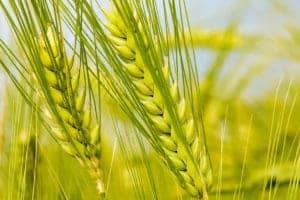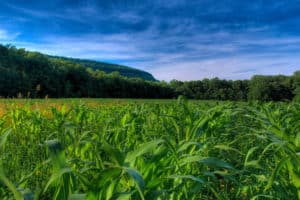Health-food advocates have kicked beef in the butt for more than 30 years. Bad for your heart, bad for your weight, bad for your risk of disease and, to boot, bad for the environment. Okay, I’ll stop.
The main culprit is corn, which feedlots give to 800-pound cattle for three to five months to get them up to about 1,250 pounds. Corn adds fat — or marbling — to meat. Fat adds taste that Americans expect and like.
Feedlot corn is mixed with other feeds, hay, minerals, antibiotics, gain-enhancing hormones and additives, possibly urea and perhaps some “byproducts,” such as the hulls of soybeans, distillers grain, brans, whole cotton seed and poultry litter. The objective is to add pounds and taste as efficiently as possible.
This finishing process used to be called “fattening” until American consumers became fat-adverse above our shoulders.
Even as America’s population increased during the last decade, total annual beef consumption has remained at about 26.5 billion pounds +/-. That’s about 67 pounds per person at an average price last year of $4.33 per pound. Health concerns — fat, mad-cow disease, E coli contamination, health risks, hormones, etc. — and price have weakened beef consumption.
In response to worries over beef quality and healthiness, a tiny — but growing — number of farms have turned to finishing beef cattle on grass, bypassing corn and feedlots altogether. This sector is so miniscule that the U.S. Department of Agriculture does not track its numbers—pounds produced, number and size of farms, costs and value of production, profitability and growth trends. A couple of hundred grass-feeders are selling beef, is my guess.
Prior to 1940, most beef cattle were finished on grass, not corn. They were slaughtered at four or five years. Age toughens beef, so Norman Rockwell’s grandmothers had to cook their pot roasts slowly, for which we now celebrate their Iron-Chefiness.
With corn finishing, cattle are slaughtered at about 18 months. With grass, it’s about nine months longer.
To reduce birth-to-plate time, grass finishers search for the best combination of cattle genetics, forages and management practices that, at the same time, keep taste and other characteristics roughly comparable to supermarket products.
The taste and tenderness of grass-finished beef depend on the quality of the individual producer’s animals, agricultural practices and length of dry-aging hang time after slaughter. Grass beef can taste like conventional beef, or less so.
The main selling points of grass-finished beef relate to consumer welfare. It’s leaner, has less saturated fat and contains Omega-3 fatty acids. Other health claims depend on the practices of the individual producer.
Grass-finished beef is a specialty product. It may never be more than an alternative for a few farmers and a few consumers. Why might that be?
Retail price is one hurdle that most consumers won’t jump. It costs more to produce a pound of grass-finished beef than corn-finished, probably twice as much, or even three times when everything is counted. Grass feeders need more pasture and hayfield per pound produced, and this has to be high-quality land. They have to keep their animals longer before they make a sale. Grass finishing might add a pound or two per day compared with corn’s three to five pounds—this adds cost and risk. Grass-finished beef is also harder for the farmer to market. For these reasons, it has to be priced twice as high, or more.
From the farmer’s end of things, it’s debatable whether grass-finished beef makes money when all costs — including land and labor — are counted. On the other hand, the conventional cattle business has shown a profit in only two of the last 20 years. Cattle producers of all types learn early not to confuse cash income with profitability. “Cash cows” are not found on cattle farms.
Most grass-fed beef is marketed directly by producers to consumers, restaurants, natural-food shops, farmers’ markets and buyer clubs. A few supermarkets handle a few grass-fed products.
Consumers may be understandably confused by beef labels—organic, grass-finished (or pasture-finished or grass-fed) and natural.
“Organic” beef may or may not be finished with corn—organic, of course. The care and feeding of these animals must meet strict certification standards as set out by USDA’s National Organic Program in 2008.
USDA doesn’t have a certification program for grass-fed beef, but producers can request a USDA audit verification for a grass-fed claim. USDA defines a grass/forage-fed animal as one that’s been fed grass and forage for life, excepting milk consumed before weaning. These animals cannot be fed grain or its byproducts, and access to pasture must be continuous during the growing season. The USDA forage-fed label does allow grass-finished cattle to consume a few high-fiber, low-nutrient roughage supplements, such as the hulls of cottonseeds, almonds and peanuts.
And to further complicate things, “natural beef” was defined this year as coming from cattle that have been raised without growth stimulants, antibiotics or byproducts. Natural beef may or may not be finished with corn, either organic or not.
Most grass-finishers lean toward organic practices, but they’re not required. Several use antibiotics when needed, which is an organic no-no. Hay and pasture could be treated with fertilizers that would not qualify as organic.
Many grass-finished beef producers appear to be lifestyle farmers who serve lifestyle consumers. Most of these operations are small. The larger ones tend to be diversified, offer lower prices and a direct-mail capability.
A jaded greenie might smirk that the grassy part of the beef business seems to be a byproduct of liking to live on farms. Since I like to live on a farm, I should be the first struck with any stone I cast called, “lifestyle choice.”
Grass-finishing seems to be a better, healthier choice than corn finishing, but it’s far more expensive, inefficient, risky, burdensome and no more profitable.
If all cattle were finished on grass, we’d be running them on many new pastures that used to be cornfields, or using that land for other food and fuel.
The interesting question about this funny little niche is this: Is grass-fed beef cheaper than corn-fed beef when the costs of corn-related diseases are factored in?
And if it is, what policy and federal tax changes might follow if we wanted to produce the cheapest hamburger, which might also be the healthiest? Should we stop subsidizing corn and start subsidizing grass?
More research, of course, is always needed.
This content may not be used or reproduced in any manner whatsoever, in part or in whole, without written permission of LANDTHINK. Use of this content without permission is a violation of federal copyright law. The articles, posts, comments, opinions and information provided by LANDTHINK are for informational and research purposes only and DOES NOT substitute or coincide with the advice of an attorney, accountant, real estate broker or any other licensed real estate professional. LANDTHINK strongly advises visitors and readers to seek their own professional guidance and advice related to buying, investing in or selling real estate.









Good article.